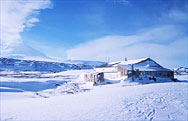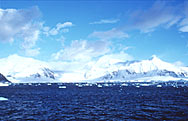It is often said that the rich marine biota of Antarctica provides a wonderful "natural laboratory" for biologists. That is very true, but it would be even more true to say that it provides a large number of related but different natural laboratories for us. The scientific questions we have been asking in our past work on chemical ecology could best be answered in the natural laboratory of McMurdo Sound. The questions we are asking on this and our next trip in November-December 2001 are ones that are best suited for the natural laboratory at Palmer Station.
Palmer Station is on Anvers Island off the Antarctic Peninsula. That is directly south of South America and further north (64 degrees South) than where we have been working in McMurdo Sound, which is south of New Zealand and at 77 degrees south.
Because of differences in its oceanography, the Peninsula supports luxuriant undersea forests of macroalgae (seaweeds). And they literally are forests, with biomass levels comparable to the giant kelp forests you can see off the west coast of the United States and elsewhere.
This, coupled with some other unique oceanographic features of coastal Antarctica that affect how plants grow will allow us to answer important questions in chemical ecology on the evolution of chemical defenses that literally cannot be asked anywhere else in the world's oceans. Since they can only be asked with macroalgae or other plants, that includes not being able to do a thorough job with them in McMurdo Sound, where macroalgae are few and far between.
A second important feature of the Peninsula is that for climatic and oceanographic reasons together, we will have much greater access to early life history stages -- eggs, embryos, and larvae -- of the marine invertebrates (animals without backbones) than we did at McMurdo. This will allow us to expand upon work begun at McMurdo to address a second important question on the evolution of chemical defenses. We could do that at McMurdo but not as well or as easily as we will at Palmer.


